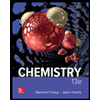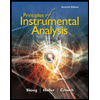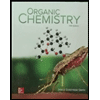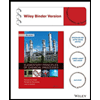
GENERAL,ORGANIC,+BIOCHEMISTRY
10th Edition
ISBN: 9781260148954
Author: Denniston
Publisher: RENT MCG
expand_more
expand_more
format_list_bulleted
Concept explainers
Question
Chapter 23, Problem 23.26QP
Interpretation Introduction
Interpretation:
The reason behind triglycerides as more efficient energy-storage molecules than glycogen has to be determined.
Concept Introduction:
Triglycerides are essentially the derivatives of glycerol where the terminal alcoholic groups are replaced by ester groups by esterification with long fatty acids. These triglycerides are hydrophobic.
The glycogen is polysaccharide that is composed of glucose units as its monomers. It is mainly present in the liver and skeletal muscles that provide the brain with the required glucose in situations of starvations.
Expert Solution & Answer
Want to see the full answer?
Check out a sample textbook solution
Students have asked these similar questions
Equimolecular mixture of acetaldehyde and 2,2-dimethylpropane with aqueous NaOH solution and subsequent heating.
2-Phenyl-2-methylbutanol with sodium hydroxide
3-Methylaniline with NaNO2 in HCl at 0°C and subsequent reaction with water in an acidic medium.
Chapter 23 Solutions
GENERAL,ORGANIC,+BIOCHEMISTRY
Ch. 23.1 - Prob. 23.1QCh. 23.1 - Prob. 23.2QCh. 23.2 - Prob. 23.1PPCh. 23.2 - Prob. 23.2PPCh. 23.3 - Prob. 23.3QCh. 23.3 - Prob. 23.4QCh. 23.4 - Prob. 23.5QCh. 23.4 - Prob. 23.6QCh. 23.5 - Prob. 23.7QCh. 23.6 - Summarize the effects of the hormone insulin on...
Ch. 23.6 - Prob. 23.10QCh. 23 - Prob. 23.11QPCh. 23 - Prob. 23.12QPCh. 23 - Prob. 23.13QPCh. 23 - Prob. 23.14QPCh. 23 - Prob. 23.15QPCh. 23 - Prob. 23.16QPCh. 23 - Prob. 23.17QPCh. 23 - Prob. 23.18QPCh. 23 - Prob. 23.19QPCh. 23 - Prob. 23.20QPCh. 23 - Prob. 23.21QPCh. 23 - Prob. 23.22QPCh. 23 - Prob. 23.23QPCh. 23 - Prob. 23.24QPCh. 23 - Prob. 23.25QPCh. 23 - Prob. 23.26QPCh. 23 - Prob. 23.27QPCh. 23 - Prob. 23.28QPCh. 23 - Prob. 23.29QPCh. 23 - What is the function of colipase in the digestion...Ch. 23 - Prob. 23.33QPCh. 23 - Prob. 23.34QPCh. 23 - Prob. 23.35QPCh. 23 - Prob. 23.36QPCh. 23 - Prob. 23.37QPCh. 23 - Prob. 23.38QPCh. 23 - Prob. 23.39QPCh. 23 - Prob. 23.40QPCh. 23 - Prob. 23.41QPCh. 23 - Prob. 23.42QPCh. 23 - Prob. 23.43QPCh. 23 - Prob. 23.44QPCh. 23 - Prob. 23.45QPCh. 23 - Prob. 23.46QPCh. 23 - Prob. 23.47QPCh. 23 - Prob. 23.48QPCh. 23 - Prob. 23.49QPCh. 23 - Prob. 23.50QPCh. 23 - Prob. 23.51QPCh. 23 - Prob. 23.52QPCh. 23 - Prob. 23.53QPCh. 23 - Prob. 23.54QPCh. 23 - Prob. 23.55QPCh. 23 - Prob. 23.56QPCh. 23 - Prob. 23.57QPCh. 23 - Prob. 23.58QPCh. 23 - Prob. 23.59QPCh. 23 - Prob. 23.60QPCh. 23 - Prob. 23.61QPCh. 23 - Prob. 23.62QPCh. 23 - Prob. 23.63QPCh. 23 - Prob. 23.64QPCh. 23 - Prob. 23.65QPCh. 23 - Prob. 23.66QPCh. 23 - Prob. 23.67QPCh. 23 - Prob. 23.68QPCh. 23 - Prob. 23.69QPCh. 23 - Prob. 23.70QPCh. 23 - Prob. 23.71QPCh. 23 - Prob. 23.72QPCh. 23 - Prob. 23.73QPCh. 23 - Prob. 23.74QPCh. 23 - Prob. 23.75QPCh. 23 - Prob. 23.76QPCh. 23 - Prob. 23.77QPCh. 23 - Prob. 23.78QPCh. 23 - Briefly describe triglyceride metabolism in an...Ch. 23 - Prob. 23.80QPCh. 23 - Prob. 23.81QPCh. 23 - Prob. 23.82QPCh. 23 - Prob. 23.83QPCh. 23 - Prob. 23.84QPCh. 23 - Prob. 23.85QPCh. 23 - Prob. 23.86QPCh. 23 - Prob. 23.87QPCh. 23 - Prob. 23.88QPCh. 23 - Prob. 23.89QPCh. 23 - Prob. 23.90QPCh. 23 - Prob. 23.91QPCh. 23 - Prob. 23.92QPCh. 23 - Prob. 23.93QPCh. 23 - Prob. 23.94QPCh. 23 - Prob. 1MCPCh. 23 - Prob. 2MCPCh. 23 - Prob. 3MCPCh. 23 - Prob. 4MCPCh. 23 - Prob. 5MCPCh. 23 - Prob. 6MCPCh. 23 - Prob. 8MCPCh. 23 - Prob. 9MCPCh. 23 - Prob. 10MCP
Knowledge Booster
Learn more about
Need a deep-dive on the concept behind this application? Look no further. Learn more about this topic, chemistry and related others by exploring similar questions and additional content below.Similar questions
- The reaction of cyclohexanone with diethylamine.arrow_forwardYou're preparing the 2-1 parenteral nutrition that uses potassium phosphate vials (3 mmol of phosphate and 4.4 meq of potassium per mL) to add the phosphate to the parenteral nutrtion. How many meq of potassium are added to the parenteral nutrition when the phosphate is added? Potassium 65 meq Phosphate 24 mmol Sterile water qs ad 2000mlarrow_forwardThe combined calcium and phosphorus in a parenteeral nutrition should not exceed 45 mEq/L. if the parenteral nutrition order shown containes 2mEq PO4/mmol, what is the combined calcium and phosphorus (mEq/L) in the parenteral nutrition order? Parenteral nutrition order: Potassium 65 mEq, Phosphate 24 mmol, Calcium 12 mEqarrow_forward
- pls help on all asked.arrow_forward29. The following reaction takes place. A2B(s) = 2A (aq) + B(aq) + heat. If 2.50 moles of A2B is added into a 2.00 L container, it is found that 25.0% of the reactant dissociates to reach equilibrium. Find the solubility product constant, Ksp, for this reaction. Note: Your answer must include an ICE table.arrow_forwardpls help on all asked.arrow_forward
arrow_back_ios
SEE MORE QUESTIONS
arrow_forward_ios
Recommended textbooks for you
 ChemistryChemistryISBN:9781305957404Author:Steven S. Zumdahl, Susan A. Zumdahl, Donald J. DeCostePublisher:Cengage Learning
ChemistryChemistryISBN:9781305957404Author:Steven S. Zumdahl, Susan A. Zumdahl, Donald J. DeCostePublisher:Cengage Learning ChemistryChemistryISBN:9781259911156Author:Raymond Chang Dr., Jason Overby ProfessorPublisher:McGraw-Hill Education
ChemistryChemistryISBN:9781259911156Author:Raymond Chang Dr., Jason Overby ProfessorPublisher:McGraw-Hill Education Principles of Instrumental AnalysisChemistryISBN:9781305577213Author:Douglas A. Skoog, F. James Holler, Stanley R. CrouchPublisher:Cengage Learning
Principles of Instrumental AnalysisChemistryISBN:9781305577213Author:Douglas A. Skoog, F. James Holler, Stanley R. CrouchPublisher:Cengage Learning Organic ChemistryChemistryISBN:9780078021558Author:Janice Gorzynski Smith Dr.Publisher:McGraw-Hill Education
Organic ChemistryChemistryISBN:9780078021558Author:Janice Gorzynski Smith Dr.Publisher:McGraw-Hill Education Chemistry: Principles and ReactionsChemistryISBN:9781305079373Author:William L. Masterton, Cecile N. HurleyPublisher:Cengage Learning
Chemistry: Principles and ReactionsChemistryISBN:9781305079373Author:William L. Masterton, Cecile N. HurleyPublisher:Cengage Learning Elementary Principles of Chemical Processes, Bind...ChemistryISBN:9781118431221Author:Richard M. Felder, Ronald W. Rousseau, Lisa G. BullardPublisher:WILEY
Elementary Principles of Chemical Processes, Bind...ChemistryISBN:9781118431221Author:Richard M. Felder, Ronald W. Rousseau, Lisa G. BullardPublisher:WILEY

Chemistry
Chemistry
ISBN:9781305957404
Author:Steven S. Zumdahl, Susan A. Zumdahl, Donald J. DeCoste
Publisher:Cengage Learning

Chemistry
Chemistry
ISBN:9781259911156
Author:Raymond Chang Dr., Jason Overby Professor
Publisher:McGraw-Hill Education

Principles of Instrumental Analysis
Chemistry
ISBN:9781305577213
Author:Douglas A. Skoog, F. James Holler, Stanley R. Crouch
Publisher:Cengage Learning

Organic Chemistry
Chemistry
ISBN:9780078021558
Author:Janice Gorzynski Smith Dr.
Publisher:McGraw-Hill Education

Chemistry: Principles and Reactions
Chemistry
ISBN:9781305079373
Author:William L. Masterton, Cecile N. Hurley
Publisher:Cengage Learning

Elementary Principles of Chemical Processes, Bind...
Chemistry
ISBN:9781118431221
Author:Richard M. Felder, Ronald W. Rousseau, Lisa G. Bullard
Publisher:WILEY
Lipids - Fatty Acids, Triglycerides, Phospholipids, Terpenes, Waxes, Eicosanoids; Author: The Organic Chemistry Tutor;https://www.youtube.com/watch?v=7dmoH5dAvpY;License: Standard YouTube License, CC-BY